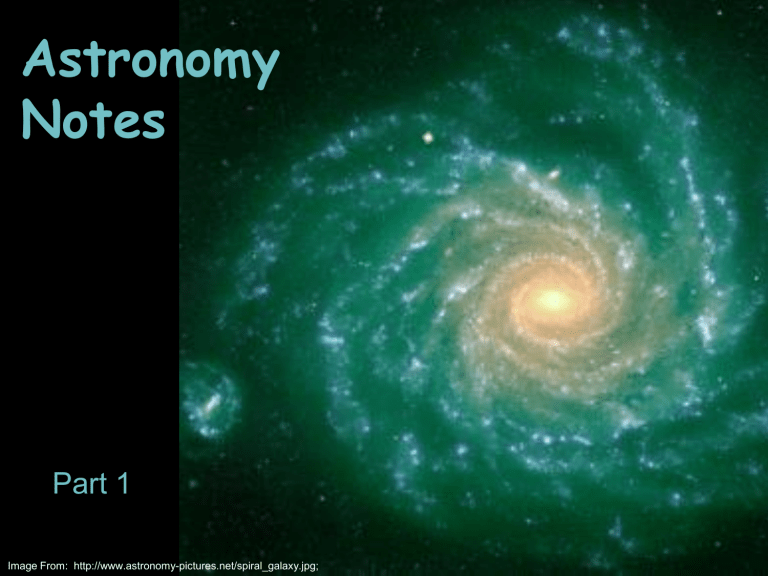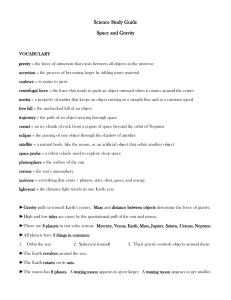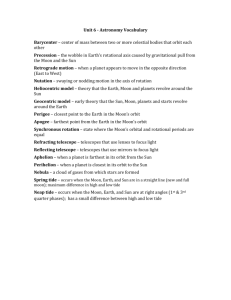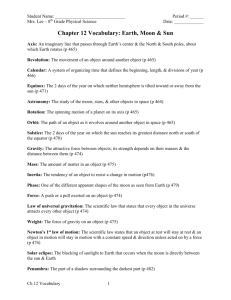The Moon and tides

Astronomy
Notes
Part 1
Image From: http://www.astronomy-pictures.net/spiral_galaxy.jpg;
Size of the planets compared to the Sun
Scale model !
The Inner Planets
and our moon
(The Terrestrial Planets)
Scale model !
The Outer Planets
compared to the Inner Planets
(The Gas Giants)
Click: http://www.youtube.com/watch?v=HEheh1BH34Q
1 of 11
Stars
• An object made of gas that gives off energy
– mainly hydrogen
– helium
The Sun
• medium in size & life span compared to other stars
• primary energy source for all processes on Earth
• much closer to Earth than any other star!
• about 4 ½ billion years old
H-R Diagram: Shows the relationship between color, temperature, magnitude & size of stars.
• C o l o r = temperature
• Magnitude = how bright
• Our Sun is a main sequence star.
Click for Life Cycle of Stars BrainPOP: http://www.brainpop.com/science/space/lifecycleofstars/
Click for Life Cycle of Stars Animation: http://sunshine.chpc.utah.edu/labs/star_life/support/HR_animated_real.html
2 of 11
Black Dwarf
Nebula
1. Large cloud of gas & dust where stars form.
2. Gravity pulls material into a sphere that becomes
4. Outer layers
3. Expands come off dense, hot
& ignites.
Explodes!
5. Collapses to just its core
3 of 11
4 of 11
Galaxy
• A large grouping of stars in space.
• 3 types
1.
Spiral – bulge in center & distinctive spiral arms
• Example: Our galaxy, The Milky Way
• Our solar system is located within an arm
2.
Elliptical – spherical or elongated
3.
Irregular
1 2 3
5 of 11
Our Solar System
Terrestrial Planet: a rocky, INNER planet
Mercury
• closest to the sun
• no atmosphere
• full of craters
• very hot during day; freezing cold at night
Venus
• Similar in size to Earth
• Hot, thick & poisonous atmosphere
Earth – home!
Mars
• known as the “red planet” because of its ironrich soil
6 of 11
Gas Giant: large, OUTER planet that is made mostly of gases
Jupiter
• largest planet
• known for its storm, “The Great Red Spot”
Saturn
• known for its ring system
Uranus
• known for blue-green atmosphere
Neptune
• blue-green atmosphere like Uranus
• Also has a storm, “The Great Dark Spot”
Moon
• A natural satellite of a planet.
• The outer planets have many of them!
Image From: http://sos.noaa.gov/images/Solar_System/moon.jpg;
Definition: www.thefreedictionary.com
7 of 11
Asteroids
Other Rocky Bodies...
• asteroid belt between Mars & Jupiter
• small, rocky body that revolves around the Sun
Meteor oids – in space (like aste roids ), but usually smaller
Meteors –
(meteor shower); a bright streak of light caused by the rock burning as it streaks through the atmosphere
Meteorites – piece of rock that has landed on Earth without completely burning up, possibly making a crater
Comet – a body of ice, rock and dust that forms a tail as it gets close to the Sun
8 of 11
Light Year
A measure of how long it takes light to travel through space in one year.
Image From: http://uniqhorns.com/images/milkyway.gif; Definition: www.thefreedictionary.com 9 of 11
Electromagnetic Spectrum
10 of 11
R
The range of all the waves that can travel through matter as well as empty space.
O Y G B I V
Scientists use different portions of the spectrum to learn about the universe.
Ex: light waves can tell us what elements stars are made & if they are moving away or towards other objects.
Image From
: http://www.lcse.umn.edu/specs/labs/images/spectrum.gif
Definition: www.thefreedictionary.com
Theories on the Origin of the Universe
1. Steady State – has always been the same
2. Oscillating Model - began by expanding, has slowed down & is now contracting
3. Big Bang *the dominant theory
• 12 to 15 billion years ago
• Universe began as a dense point that exploded
• It rapidly expanded & began to cool down, forming stars, etc.
• Evidence
discovery of cosmic background radiation
red shift in EM spectrum suggest it is still expanding
11 of 11
Click for Big Bang BrainPOP: http://www.brainpop.com/science/space/bigbang/
Astronomy Notes
Part 2
Lunar
Cycle
Full moon: all of surface facing Earth is illuminated (= lit ) by the Sun
New moon: moon is between Earth & Sun, so lit portion is facing away from Earth
Waxing moon: lit portion “growing”
Waning moon: lit portion “decreasing”
Gibbous moon: larger than ½
Crescent moon: smaller than ½
Can you I.D. these phases?
- Where is the sun in this diagram?
Rotation vs. Revolution
Rotation:
• spin of object on its axis
• rotates counter-clockwise = west to east
= why sun appears to rise in the east and set in the west
• for Earth = 24 hrs. =1 day
• responsible for day vs. night
Revolution:
• also called an orbit
• path of one object around another
• Earth around sun ≈ 365 days = 1 year
• moon around Earth ≈ 1 month
The Earth is tilted on its axis by 23.5.°
As a result, the hemisphere that is tilted toward the sun receives more direct sunlight = more heat.
• causes longer daylight hours
• hotter temperatures = summer!
The hemisphere tilted away from the sun experiences winter.
The
TILT
is the reason for seasons!
For the Northern
Hemisphere!
= least daylight hours
= Equal hours of day and night
= most daylight hours
Tides
Tide = daily rise & fall in ocean water level
• high and low tides occur twice daily
• high tides are caused by the gravitational pull of the moon & sun, causing the ocean water to “bulge” away from the Earth
• the moon has a greater impact because it is closer
High tide occurs on the side facing the moon, but it also occurs on the opposite side.
This is because the moon is also pulling the Earth away from the water on the other side.
Low Tide
Tidal bulge
High Tide
Low Tide
High Tide
Gravitational pull of the moon
moon and sun pull together = largest tides moon and sun pull against each other = weakest tides






